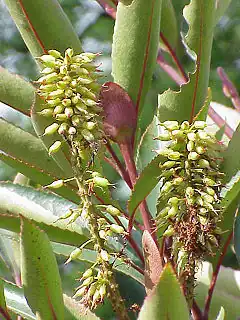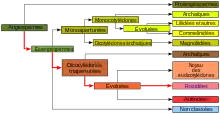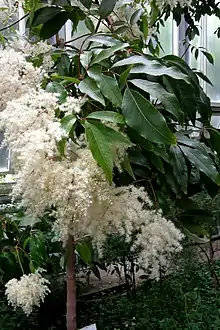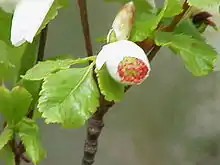Cunoniaceae
Les Cunoniaceae sont une famille de plantes dicotylédones comprenant presque 300 espèces réparties en une vingtaine de genres.

| Règne | Plantae |
|---|---|
| Sous-règne | Tracheobionta |
| Division | Magnoliophyta |
| Classe | Magnoliopsida |
| Sous-classe | Rosidae |
| Ordre | Rosales |

Ce sont des arbres et des arbustes des régions tempérées à tropicales plutôt originaires de l'hémisphère sud.
Étymologie
Le nom vient du genre type Cunonia nommé en hommage au poète écrivain botaniste et commerçant allemand Johann Christian Cuno (en) (1708–1783). Très lié à la Hollande, il écrivit en 1750 un poème décrivant le jardin exotique qu'il avait planté près d'Amsterdam. Il écrivit aussi une poésie accompagnant la description du genre Wachendorfia (Haemodoraceae), honorant les botanistes néerlandais Evert Jacob van Wachendorff (de) (1703-1758) et Johannes Burman (1707-1780)[1].
Classification
La classification phylogénétique APG II (2003)[2] situe cette famille dans l'ordre des Oxalidales. En outre, elle y intègre les genres Bauera et Davidsonia endémiques d'Australie (Respectivement placés dans les Baueraceae et les Davidsoniaceae, en classification classique) et le genre Eucryphia, placé dans la famille des Eucryphiaceae en classification classique.
Le genre Aphanopetalum est, lui, placé à part pour constituer la famille des Aphanopetalaceae.

Liste des genres
Selon Angiosperm Phylogeny Website (11 décembre 2016)[3] :
- Ackama A. Cunningham
- Acrophyllum Bentham
- Aistopetalum Schltr.
- Anodopetalum A.Cunn. ex Endl.
- Bauera Banks ex Andr.
- Caldcluvia D.Don
- Callicoma Andrews
- Ceratopetalum Sm.
- Codia J. R. Forster & G. Forster
- Cunonia L.
- Davidsonia F.Muell.
- Eucryphia
- Geissois Labill.
- Gillbeea F.Muell.
- Hooglandia McPherson & Lowry
- Karrabina Rozefelds & H. C. Hopkins
- Lamanonia Vell.
- Opocunonia Schlechter
- Pancheria Brongn. & Gris
- Platylophus D.Don
- Pseudoweinmannia Engl.
- Pullea Schltr.
- Schizomeria D.Don
- Spiraeanthemum A.Gray
- Spiraeopsis Miquel
- Vesselowskya Pamp.
- Weinmannia L.
Selon NCBI (11 décembre 2016)[4] :
- Ackama
- Acrophyllum
- Acsmithia
- Anodopetalum
- Bauera
- Caldcluvia
- Callicoma
- Ceratopetalum
- Codia (endémique de la Nouvelle-Calédonie)
- Cunonia
- Davidsonia
- Eucryphia
- Geissois
- Gillbeea
- Hooglandia
- Karrabina
- Opocunonia
- Pancheria (endémique de la Nouvelle-Calédonie)
- Platylophus
- Pseudoweinmannia
- Pullea
- Schizomeria
- Spiraeanthemum
- Spiraeopsis
- Vesselowskya
- Weinmannia
Selon DELTA Angio (11 décembre 2016)[5] :
- Acrophyllum
- Acsmithia
- Aistopetalum
- Anodopetalum
- Caldcluvia
- Callicoma
- Ceratopetalum
- Codia
- Cunonia
- Geissois
- Gillbeea
- Gumillea
- Lamanonia
- Pancheria
- Platylophus
- Pseudoweinmannia
- Pullea
- Schizomeria
- Spiraeanthemum
- Vesselowskya
- Weinmannia
Selon ITIS (11 décembre 2016)[6] :
- Eucryphia Cav
- Weinmannia L.
Notes et références
- (en) Maarten J M Christenhusz, Michael F Fay et Mark W. Chase, Plants of the World : An Illustrated Encyclopedia of Vascular Plants, Chicago, The University of Chicago Press, , 792 p. (ISBN 978-0-2265-2292-0), p. 299
- (en) Angiosperm Phylogeny Group, « An update of the Angiosperm Phylogeny Group classification for the orders and families of flowering plants: APG II », Botanical Journal of the Linnean Society, Wiley-Blackwell, Linnean Society of London et OUP, vol. 141, no 4, , p. 399–436 (ISSN 0024-4074 et 1095-8339, DOI 10.1046/J.1095-8339.2003.T01-1-00158.X)
- Stevens, P. F. (2001 onwards). Angiosperm Phylogeny Website. Version 14, July 2017 [and more or less continuously updated since]." will do. http://www.mobot.org/MOBOT/research/APweb/, consulté le 11 décembre 2016
- NCBI, consulté le 11 décembre 2016
- DELTA Angio, consulté le 11 décembre 2016
- Integrated Taxonomic Information System (ITIS), www.itis.gov, CC0 https://doi.org/10.5066/F7KH0KBK, consulté le 11 décembre 2016
Liens externes
- (en) Référence Madagascar Catalogue : Cunoniaceae
- (en) Référence Flora of Chile : Cunoniaceae
- (en) Référence Trees and shrubs of the Andes of Ecuador : Cunoniaceae
- (en) Référence Angiosperm Phylogeny Website : Cunoniaceae ()
- (en) Référence Jardin botanique du Missouri : Cunoniaceae (images de Madagascar)
- (en) Référence DELTA Angio : Cunoniaceae R. Br.
- (en) Référence Tree of Life Web Project : Cunoniaceae
- (en) Référence Catalogue of Life : Cunoniaceae R. Br. (consulté le )
- (fr) Référence Tela Botanica (La Réunion) : Cunoniaceae
- (en) Référence Paleobiology Database : Cunoniaceae Brown
- (fr+en) Référence ITIS : Cunoniaceae
- (en) Référence NCBI : Cunoniaceae (taxons inclus)
- (en) Référence UICN : taxon Cunoniaceae (consulté le )
- (en) Référence GRIN : famille Cunoniaceae R. Br. (+liste des genres contenant des synonymes)
- Famille Cunoniaceae (Association Endémia)
